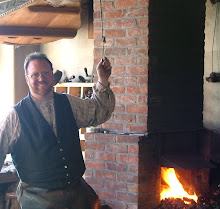Our chain is being made from 3/8th inch diameter low-carbon steel rod. This is the closest readily available equivalent to the wrought iron bar used in the 1840s. Each link starts out as a piece of rod 7 inches long. The first step is to hammer a scarph (steep taper) on each end. The scarphed ends allow the link to be welded with the fire, hammer, and anvil.



A chain of 25 feet in length will need about 127 welded links! They are assembled three at a time. One open link is used to connect two welded links. The open link is then welded shut to make a section of three links. Two sections of three are then welded together with an open link to form a chain of 7. That short chain is then welded onto the longer length.
 The chain is currently 9 feet long, and I will be adding 4 sections to it today. I can make a seven-link section per hour while talking, and add about 3 feet of chain per day. Our oxen, Jigs and Buckwheat, should have their new chain in another week.
The chain is currently 9 feet long, and I will be adding 4 sections to it today. I can make a seven-link section per hour while talking, and add about 3 feet of chain per day. Our oxen, Jigs and Buckwheat, should have their new chain in another week.

Are there any special tools used when making chain?
ReplyDeleteExcellent Question! In the past professional chain makers used a special tool called a "Striking tommy" or "Tommy hammer". This was a matched set of top and bottom dies and was used to size the link to an exact shape. That was the last step done to a forged and welded link.
ReplyDeleteI don't use one, as a village blacksmith wouldn't have had one. I use just my hammer and the anvil face and horn. That leaves the welded end of each link slightly flattened, which matches examples I have seen of old forged chain.